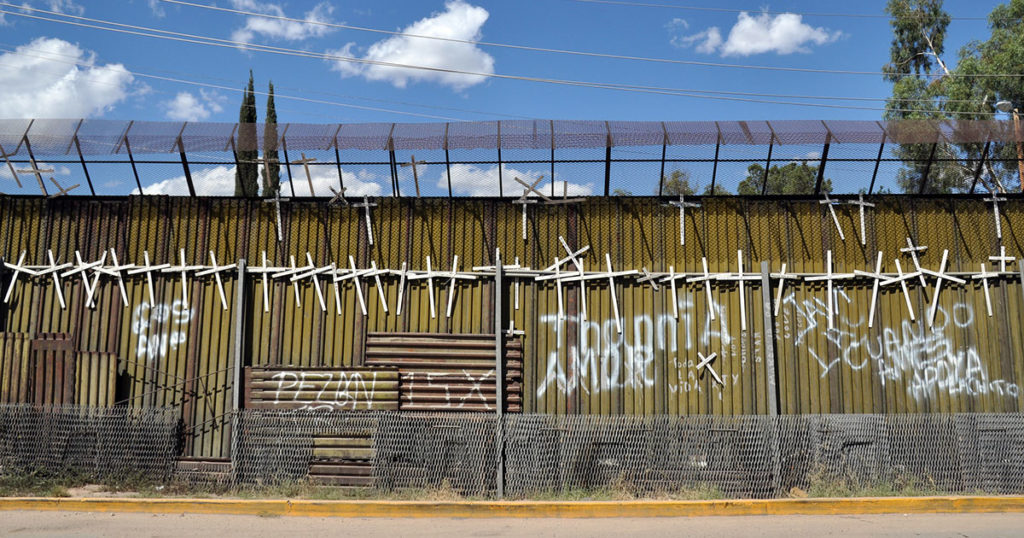
There are eight of them: miniature slabs of concrete and steel, each just 15 inches high. Despite their size, they appear imposing, even while conveying a sense of numbing banality. On closer inspection, various distinguishing details reveal themselves: here a rounded steel top, there an outward jog of concrete. A few of the slabs are not much more than sand-colored monoliths, but one hybrid version—white concrete on the bottom, blue steel on the top—is so aesthetically outlandish that the design appears almost ironic. If these models look vaguely familiar, that’s because you probably remember the real versions from a few years ago. The mini slabs, now on display at the National Building Museum in Washington, D.C., are scaled replicas of the border wall prototypes that the Trump administration built in Otay Mesa, California, in 2017.
Designed by various construction and defense firms after the U.S. Customs and Border Patrol (CBP) issued a request for proposals, the prototypes were intended to herald a new era in border security, providing a perfect photo op for a president who had promised to Build the Wall and make Mexico pay for it. The replicas are part of “The Wall/El Muro: What Is a Border Wall?”—a yearlong exhibition that takes a wide look at our southern boundary, documenting the rise of our border-industrial complex and how politics and social issues often intertwine with matters of architecture, design, and engineering. In the early 1900s, when the federal Bureau of Animal Industry built the first fencing along our boundary with Mexico, to stop the spread of hoof and mouth disease among cows, no one could have envisioned the hypercharged development around the border more than a century later. Witness the prototypes. For an administration enamored of makeshift props (Bibles held aloft, hurricane maps doctored in Sharpie, fake books containing nonexistent health care plans), the prototypes stood a cut above, both in their sheer scope—each was 30 feet by 30 feet—and chilling effect. “Here were the techniques of Land Art, medieval construction, marketing and promotion, architectural exhibition, and the new nativism rolled uncomfortably if somehow inevitably into one,” wrote Christopher Hawthorne, then the architecture critic of the Los Angeles Times.
The border wall as design object gave critics pause. Were the prototypes art, aesthetic objects meant to be parsed, or was it irresponsible to treat them as such and validate a naked display of political posturing? When a Swiss-born artist named Christoph Büchel arranged tours and lobbied for the large slabs to be designated a national monument, his campaign was met with an open letter, signed by hundreds of artists, curators, and educators, which called for a boycott of his gallery and said that “nothing about a xenophobic and white supremacist project, artifact, wall, or building should ever be spectacularized and promoted by artists or arts institutions.”
The models inspire no such handwringing. They are the handiwork of Ane Gonzalez Lara, an assistant professor at Pratt Institute’s School of Architecture, and Meryem Es Saoudi, her research assistant. The two designers experimented with steel and concrete fabrication as they re-created the prototypes, each 1/24th the size of the originals. If they are slightly rough and ready—the concrete not quite smooth, the edges imperfect—that’s only in keeping with the spirit of the originals. Looking at photos of the real ones in situ, they appear menacing, haunting even. But here, staged under a glass case, far removed from the border, the replicas don’t harbor the same power. Here they are not props in a display of political theater but rather artifacts of agitprop meant to be studied.
To see them in the exhibition is to see them reduced to their flawed essence. For all their symbolism, the prototypes were abject failures when it came to actual performance. According to a CBP report, when put to the test with plasma cutters, saws, and other classified methods, the prototypes could all be breached. (“Show me a 50-foot wall, and I’ll show you a 51-foot ladder,” Janet Napolitano famously quipped in 2005, when she was governor of Arizona.) A Government Accountability Office report was no less damning: “CBP Is Evaluating Designs and Locations for Border Barriers but Is Proceeding Without Key Information,” read the subtitle, followed by an accounting of all the design factors that had been overlooked, such as the difficulty and additional cost of building on sloping terrain. Compromised by the testing, the prototypes were demolished in 2019 to make way for replacement border fencing built using an old steel-slat design.
What should we make of the prototypes? “The Wall/El Muro,” curated by Sarah Leavitt, now on staff at the Capital Jewish Museum in Silver Spring, Maryland, isn’t an ideological screed. But it offers a gentle nudge, reminding us of the nuanced realities of the border that were overshadowed when it became shorthand for a political ideology—and, to that end, reminding us of what should be obvious: that building an impenetrable barrier along the entirety of a boundary that winds 1,954 miles through tribal lands, private property, and the Rio Grande is a fool’s errand, not to mention an environmental and financial boondoggle. In that respect, the replicas are an artifact of our not-too-distant political past.
But they also signal the future. In mid-November, Governor Greg Abbott of Texas, as part of an operation called “Steel Curtain,” unveiled a partial border “wall” made of 20 shipping containers, which architects have often employed as a means of temporary and permanent housing—see the pages of Dwell magazine. Here, in the border town of Eagle Pass, the aesthetic isn’t minimalist chic but maximalist force. Rows of police cruisers appear behind the makeshift wall in a video the governor posted on Twitter. Never mind that shipping containers are in short supply as global supply chains are snarled, and never mind a cost-benefit analysis of the undertaking—the image is the thing, and during Abbott’s reelection campaign next year, the image will be priceless.

